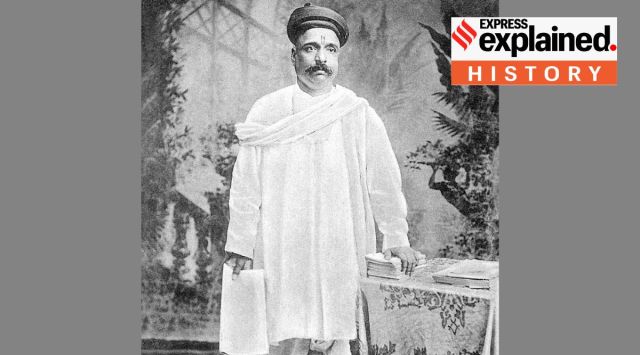How Bal Gangadhar Tilak made the worship of Lord Ganesh a grand community festival
The year was 1893, and Lokmanya, the great patriot, was looking for ways to unite and mobilise Hindu society against colonial rule. He sought to leverage practices rooted in Indian culture and suffused with Hindu symbolism. But he has also been criticised in some quarters. Why?
 Bal Gangadhar Tilak in 1905. (Photo: Wikimedia Commons)
Bal Gangadhar Tilak in 1905. (Photo: Wikimedia Commons) The 10-day Ganesh festival will be celebrated beginning September 6 (Ganesh Chaturthi) in 2024. Marked with great devotion and festivity across India and especially in the western regions of the country, the festival is a massive public event that sees mass participation.
Prior to 1893, the festival used to be a one-day affair, largely observed in private, primarily by Brahmins and upper castes. However, something changed that year, eventually leading to the grand celebrations we see today.
What happened? We take a closer look.
The man who was primarily responsible was the great nationalist and patriot Bal Gangadhar Tilak, referred to as ‘Lokmanya’, or the Leader of the People.
In the last decades of the 19th century, a number of nationalist figures emerged across India (and some in Britain), who spoke about modern civil and political rights, and the hypocrisy and exploitation of British rule in India.
Following the experience of 1857, when an attempt by soldiers of the Indian army to overthrow the British failed and the rebellion was ruthlessly crushed, many of these nationalist figures became more concerned with getting concessions from the British rather than throwing off the colonial yoke altogether.
One prominent Indian nationalist, however, had a more radical aim: Swaraj or self-rule. This was the Marathi journalist, teacher, and political and social activist Bal Gangadhar Tilak (1856-1920). In 1881, Tilak, along with G G Agarkar, founded the newspapers ‘Kesari’ (in Marathi) and ‘Mahratta’ in English, and used them to spread nationalist resistance against British rule. He was fiery and fearless, and used a direct language that found a large audience.
In the period prior to the emergence of Mahatma Gandhi, the Lokmanya was arguably the tallest mass leader in India’s anti-colonial movement, and one of the most radical. At a time when home rule was still a very distant dream, Tilak would famously declare (in Marathi): “Swaraj is my birthright, and I shall have it.”
To mobilise the people against British rule, Tilak invoked pride in Indian heroes, and relied on political campaigns that were suffused with Hindu imagery and symbolism.
In 1893, he started the new tradition of worshipping Ganpati, the Lord Who Would Remove Obstacles and bring good luck, as a community festival where patriotic songs would be sung and nationalist ideas would be propagated. Through his writings, fiery speeches, and organisational nous, Tilak encouraged and advocated bringing the Ganesh festival into the public sphere.
“Ganesh festival societies were founded all over Maharashtra. Youths organised themselves into bands of singers. Gymnastic societies were encouraged, and deeds of self-denial and valour were put forth for emulation before the young by fiery speakers and priests during the days of the festival,” wrote Dhananjay Keer, quoting Tilak himself, in the Lokmanya’s biography (‘Lokmanya Tilak: Father of the Indian Freedom Struggle’, 1959).
To further the cause of nationalist resistance, Tilak started the Shivaji festival in 1896. The aim was to inspire nationalist ideas among young Maharashtrians. That same year, he organised a campaign in Maharashtra to boycott foreign cloth to protest the imposition of an excise duty on cotton.
However, Tilak has been criticised for giving the freedom struggle a communal shade and for his conservative stand on women’s emancipation and caste reforms.
The year 1893 saw a wave of communal clashes between Hindus and Muslims across the country. On August 11, the city of Bombay saw violence at a scale it had not witnessed before. Tilak, who was based in Poona (now Pune), attacked the British for fomenting communal tensions, and also accused them of being partisan (towards Muslims).
“The Hindus had no alternative but to beat back Muslim aggression when Government protection failed … they resort to violence only under provocation,” Keer wrote, quoting Tilak, in his biography. According to Tilak, the British sided with Muslims because they saw “the danger of a Hindu majority which was gradually awakening” (Keer, 1959).
These communal clashes and the sentiments they had triggered among Hindus were, in fact, the trigger for Tilak’s efforts to consolidate and unify Hindus, channelling their energies and building solidarity through community activities such as the Ganesh festival.
The festival that we witness today is perhaps grander than Tilak himself had ever imagined. It has also undergone major shifts over the years, becoming a space where political parties are ever active and commerce thrives. But at its heart, it is still a product of Tilak’s vision — a grand public celebration, marked by mass participation across the Hindu fold.
- 01
- 02
- 03
- 04
- 05






































